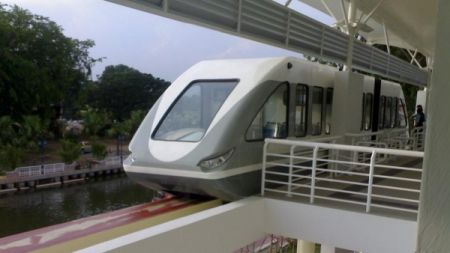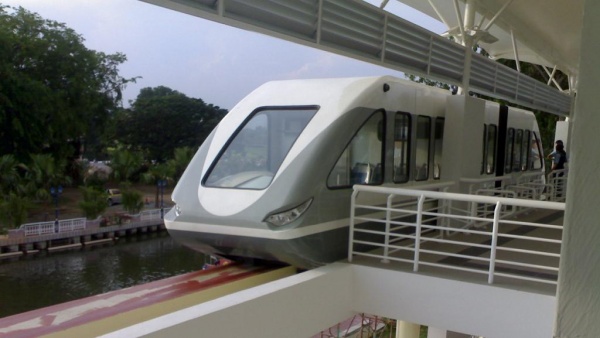There has been much hoo-ha of late about the new monorail in Melaka. Far too many technical glitches have taken place since its completion and launch.

To say the least, in the politest possible manner, it was discouraging to see how VIPs were rescued from the monorail within hours of its initial operation. The system, which was supposed to cover a distance of 1.6km and costing a total of RM15.9 million, was then suspended by the Land Public Transport Commission (SPAD) following a recent fiasco where foreign tourists were trapped in the monorail.
In my humble opinion, the same money could have been better spent to upgrade the public land transport system in Melaka. It is a known fact that, given the limited space in Melaka, most of its roads (in town, especially), are naturally narrow. This is coupled with the fact that there are very few taxis and buses which serve the town. Furthermore, many of the buses are fairly old, emitting large amounts of black smoke, or toxic carbon dioxide.
On the historical day of 20th October 2010, the state of Melaka was declared as developed. There were ample statistics to back this up, that I cannot dispute. But the fact remains that there is still much to do to improve our public transport system.
The Melaka State Government further declared it to be a Bandar Teknologi Hijau. This is plausible and, indeed, very encouraging. The Chief Minister had even gone on to encourage the State EXCO members to cycle to work and use hybrid cars to reduce carbon dioxide gas emission. Again, I applaud this fantastic effort.
However, when we look at the number of old buses that are still going around town, emitting their choking amounts of black smoke, the State Government obviously has to do more to show its commitment and seriousness in going green.
To strengthen the State Government’s impression in this regard, and to truly make Melaka a Bandar Teknologi Hijau, I have two suggestions:
Firstly, to minimize the emission of carbon dioxide gas, we need to upgrade and change the parts of those buses which exceed the carbon dioxide emission limit. This should be set at a reasonable level, paying serious consideration to the level of toxic gas emitted and how it affects the health of citizens and the environment. Alternatively, a simpler implementation would be a ruling for buses older than ten years to be replaced. In this respect, the State Government should work with the bus operators as it would undoubtedly be too burdensome on the latter to replace the buses at their own expense. Hence, while bus operators should be compelled to upgrade their fleet, the State Government should also provide significant subsidies for the purchase of new buses. A similar approach may also be adopted in regards to taxis.
Secondly, cars, buses, motorcycles and whatnot tend to emit a lot more carbon dioxide. In a bid to truly go green, a “Greater Melaka Plan” should be drawn up, part of which should include a proper rail transport system. And by proper (this bears emphasis) it can be an LRT, MRT or any such system, except a monorail. I am no expert in town planning, nor am I armed with sufficient knowledge to draw up a sound plan for rail transport, but suffice to say that the system should aim to connect the major spots in Melaka town, making them more easily accessible.
Provided we have a proper system in place, we can emulate that which has been done in London and Singapore to reduce the usage of private cars and motorcycles; that is, by introducing congestion charges. For a start, the charge should first be imposed against foreign registered cars (i.e. cars registered overseas, as well as cars registered outside the state). This will enable the State Government to more accurately gauge the number of vehicles owned and used within the state. Should the statistics reveal domestic (Melaka) usage to be too high, congestion charges can then be extended to cars registered within Melaka during peak hours. A point to note here is that, in Melaka, peak hours not only include going to and returning from work, but also the time when students go to and fro from school. This is very much due to the limited space in Melaka. More noticeable is during weekends when tourists flood the town, giving reason for congestion charges to be imposed, say, between 10am and 3pm on weekends.
These, to me, could help to reduce the emission of carbon dioxide and would truly reflect the serious efforts of the State Government to go green. Only then we Malaccans can stand proud to call our Bandar Melaka, Bandar Teknologi Hijau.


Great and amazing post.
I have rare info received from this locale. This is the exemplary blog besides crowded of info. We should division other approaches.
Great article, with a lot of good advice. Your blog is very informative. Thank you for sharing this post.
Good information and thanks for this blog and here is the most valuable information and definitely, i will be a regular visitors to this website.
I am getting the more and perfect chances about the great services and wonderful techniques as well. Keep follow the blog and more services for the traveling process and better techniques as well.
great work dear
http://www.travelwkly.com/
This post is just amazing loved it keep posting such information on daily basis thanks for your views on it. loved it.
Its a good thinking about public transport system. To reduce the pollution limo service doing better. This transport is eco-friendly about environment.
Nice.
Good effort and contribution towards the end of pollution and I glad to see your beautiful blog early in the morning and stay blessed
ggdfgfdg
In our place this public transport needed to be improved for providing the better traveling facilities to the public. It sure seems to be a good point to make discussion about it.
Nice and most effective post about The Melaka monorail transport system. we can't end of described this transport system. it's the very attraction for any traveler when any one travel for innovation and vocation. if you want to know how to push your investment and long time. you can enjoy your saving and valuable time with travel
Limo Service Austin
Awesome post !
The Penang government is the only government in the country which puts its anti polution policy into practice. It had launched a no car day and provided a track for this. This is a good start. The project can be further improved by allocating funds to build proper bicycle and walking tracks which extends throughout the city, making it possible for people to cycle to work. There must be regular rest areas for shelter from rain and toilet facilities, togather with food stalls. If we depend on SPAD, it is only interested in mega projects, leaving a host of unresolved problems, like stoppage of bus services and chronic traffic jams in the Klang Valley.